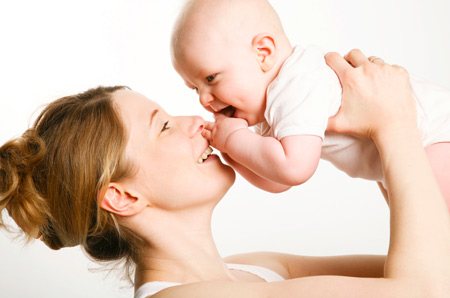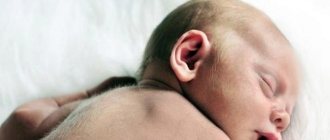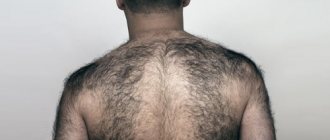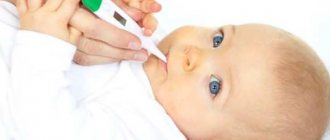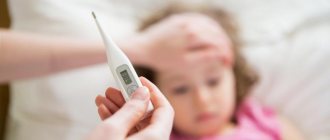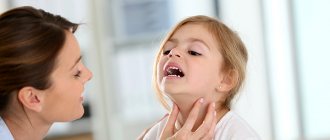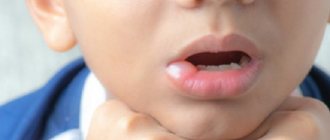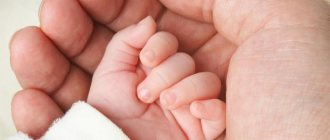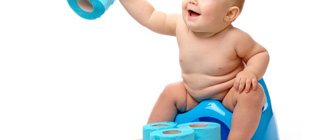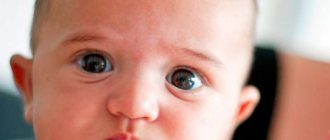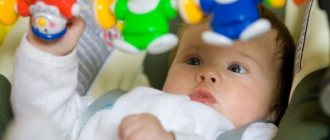The hair on the head of newborns is thin and delicate, and feels like fluff to the touch. With age, the color and structure of the rods change. They will become stronger in the future. Almost all children are born with a “hairstyle”. The amount of hair and color depend on the hereditary factor. When they begin to change their appearance, this indicates a change in hormonal levels.
Girl with red hair
What determines the amount of hair in a newborn?
A newborn's hair begins to change almost immediately after birth. About 50 rods fall out per day. New hairs quickly appear in their place. The baby's head constantly rubs the back of his head against the surface of the crib, so a bald patch forms in that area. When the baby begins to sit, new hairs grow there. The bulbs (the so-called lower ends of the hairs) form a new process after the hairs fall out.
If your child's baldness is causing you concern, you should consult a doctor. The science of histology will help determine the health of the hair. The amount of hair a newborn has depends on the genetics of the parents. This is a hereditary factor that is formed at the moment of conception.
Important! It is impossible to influence the color and structure of a baby's hair.
Features and structure of hair
A newborn develops fine hair on his body. During this period of development, the child’s hair has not yet strengthened at the root and sits quite loosely. Gradually, it strengthens in the follicle, losing its original softness and, thus, requiring more nutrients for tissue growth. Subsequently, changes in shade and type occur. Sometimes, as toddlers approach one year of age, the thin hair that appeared at birth falls out, and in its place new, coarser hair appears. At this point, the mother simply thinks that the child’s hair is not growing well. This happens even to those children who were born with little hair.
What is a newborn's hair like?
Lanugo in newborns - what is it when it disappears
Babies are born with a little fluff on their heads. It can be light, very sparse, curly, sometimes, on the contrary, black, long and thick. In fact, the first hairs do not play any role for the future hairstyle.
The rods and bulbs are formed in utero; at 2-3 months of life they completely change. Therefore, the baby may have a different hair color in the future. Such changes are associated with the amount of melanin and the hormonal background of the baby.
According to popular wisdom, it is believed that it is impossible to cut a child’s hair before one year of age - this will have a bad effect on the baby’s memory. In fact, this can be done. Therefore, many parents learn how to properly shave their baby's head.

The baby is smiling
Hair in babies
Not all babies are born with thick hair. Some are born completely bald. Those children who were born with wonderful thick hair, after a certain time, begin to go bald in the back of the head. This happens because the hair on the back of the baby's head is wiped as a result of turning the head from side to side.
Note! A receding hairline develops in 90% of children within six months. This is an absolutely natural phenomenon. The hairline will recover on its own when the baby begins to move without the help of parents.
Hair on the baby's head appears in the womb, starting from the 15th week of gestation. This is not yet a real cover, but only baby fluff, which by the first 4 months of life changes to real one. In some cases, the process is quite long and the fluff can be observed for up to 18 months. Children's hair is very delicate and can simply fall out under the influence of negative factors. For example, incorrectly selected care products. Shampoos can cause harm and lead to the formation of a bald spot on the back of a baby’s head. It is not recommended to wash your newborn's hair too often. Once a week is enough.
How to help baby hair grow
How the upper teeth grow in babies - sequence
How to properly shave a newborn's head? This is a difficult procedure for a child - he may misunderstand the parents' intentions and become very capricious. There is no point in cutting a baby's hair until he is one year old. Permanent hair color and structure are formed only by the age of 5.
It is believed that shaving helps strengthen the bulbs and roots. Many grandmothers talk about good results after they performed this procedure with their babies. Don't worry about your baby's hairstyle. In the future, the hair may lighten and then darken again, this is normal.
How to speed up hair growth in a child?
The first thing to do if your baby's hair has become brittle, dry or sparse, or has begun to grow slowly, is to reconsider his diet.
Here are some tips for organizing it:
- Refuse fast food and carbonated drinks in favor of vegetables and fruits containing beta-carotene and vitamin A, juices, compotes and fruit drinks made from them (pumpkin, carrots, bell peppers).
- Stimulate hair growth and increase keratin production to protect hair follicles through products with vitamins B7 (biotin), C, B, magnesium, calcium (dairy products, cauliflower, apples, banana, citrus).
- Get omega-3 fatty acids from sunflower and flaxseed oil, fish, nuts, and legumes.
- Add meat and eggs to your diet to restore hair structure, which is 70% protein.
- Compensate for vitamin D deficiency by frequent walks in the fresh air on sunny days, eating greens and leafy vegetables (spinach, sorrel, dill, Chinese cabbage).
If the child’s age allows, then you can use combined medications - children’s vitamin and mineral complexes.
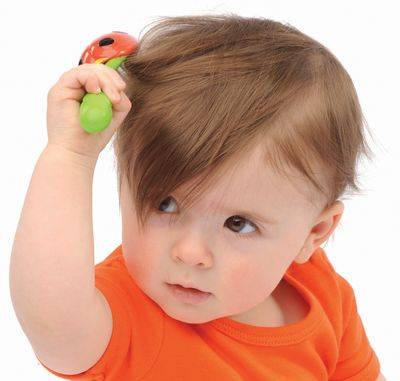
How fast does baby hair grow?
Hair growth in a newborn boy or girl depends on the genes of the parents. During the first year of a baby's life, the rods do not grow as actively. The top of the baby's head may be bald, but in the future it will become overgrown. As the child approaches two years of age, most of the bulbs open, and the bald spots become overgrown.
Crusts on a baby’s head - how to remove them
Hair falls out more strongly at the back because the child is constantly in a horizontal position. When he begins to sit and walk, a new hairstyle will form. Mothers of girls whose hair growth is slowing down are especially worried. Don't worry about this. In some children, the follicles open later.
Important! There is no scientific evidence that shaving helps stimulate hair growth.
Proper care of children's hair:
- One of the most important aspects of hair care is washing your hair. Pay special attention to the composition of baby shampoos. Give preference to well-known, proven brands over unfamiliar manufacturers, and even better, don’t be lazy to study the composition every time. Baby shampoos should not contain strong fragrances, synthetics, dyes or preservatives. Choose tear-free shampoos;
- Gentle massage of the baby's head has a beneficial effect on hair growth. The flow of blood to the head, which occurs during the massage, strengthens the hair follicles and thereby stimulates hair growth and prevents hair loss. In addition, a light head massage will help the baby relieve tension, relax, and make it easier for him to fall asleep;
- If your girl's hair grows quickly, remember to trim the ends every 6-8 weeks. Healthy hair grows much faster than hair with split ends;
- At such a tender age, you should not dry your child’s hair with a hairdryer. They don't need this stress at all. In addition, limit to a minimum the use of various hairpins, bobby pins, and hairpins, especially those with sharp edges. No tight elastic bands, curling irons, hairspray or straightening irons! Don't rush, moms, everything has its time!
- When choosing a comb, proceed from the child’s hair type. If your baby's hair is curly, it is better not to use a massage brush - buy a seamless comb with wide teeth. Metal combs are also unacceptable, they can injure the scaly layer of hair, which will lead to its fragility, fragility and slow growth;
- Use natural herbs and oils to care for children's hair. Excellent results can be achieved by rinsing the baby's head with decoctions of calamus root, burdock, nettle, and chamomile. In addition, there is such a miraculous hair remedy as burdock oil. It enriches the skin with beneficial natural substances, promotes hair strengthening and growth. You will not achieve this effect with the most expensive chemical compounds. Just rub a small amount of burdock oil into the roots of the hair, wrap the baby's head in a diaper or towel and leave for a while. After this, wash your hair as usual.
First hair problems
Some babies experience scalp and hair problems that are easily treated. Most often noted:
- Milk crusts. This is a collection of skin flakes that adhere to its surface. They disappear completely by one year. To speed up the process, they are lubricated with baby oil.
- Baldness. A baby loses 50 hairs a day. In their place, new rods quickly grow. It happens that bald patches appear on the head. If they do not begin to heal, then you need to consult a doctor.
- Split ends. The tips of the rods are damaged under the influence of environmental factors. In rare cases, this indicates skin dysbiosis.
Any problems that children have can be resolved. If they cause increased concern, you should consult a doctor.
Problems with baby's first hair
Most problems with a baby's first hair are determined by natural physiological causes, and this is normal for a child of the first year of life. Among these reasons are insufficient development of the hair follicle and shaft, inactive sebaceous glands, poor blood supply to the hair follicles and scalp. However, some problems are caused by a malfunction of some of the baby’s systems, most often the digestive system, and in this case it is necessary to contact a pediatrician and get tested.
Among the problems that await a baby’s first hair, pediatricians note:
Crusts
They often appear on the head of newborn babies and represent an accumulation of dead, keratinized skin flakes. To combat this problem, you need to lubricate the baby’s head with warm baby oil (or regular refined vegetable oil, calcined in a water bath and cooled to a comfortable temperature) a couple of hours before bathing. During bathing, the crusts are combed out with a child's comb with rounded teeth. Most likely, the problem will not be solved in one bath; this is quite normal.
Attention! Scratching dry crusts is unacceptable, as this can injure the baby’s scalp!
The problem of crusts should be resolved naturally by the time the baby reaches one year of age. If the baby is older, and new crusts continue to appear, consult a doctor about this problem - this may indicate diseases of the baby’s digestive system.
Hair loss
The baby's first hairs fall out naturally, later being replaced by coarser, adult hair. Up to 50 hairs can fall out per day; if this number is significantly higher, contact your pediatrician or pediatric dermatologist. Another reason for hair loss in a child is the crusts described above. The hairs are “combed” off the baby’s head along with the scabs, usually after a week or two new ones appear in their place. If this does not happen, you should show the baby to a doctor.
Split ends
The baby's delicate first hairs are especially susceptible to aggressive environmental influences. Dry and warm air in artificially heated rooms in winter, exposure to wind and sunlight in summer, washing your hair with too hot water or blow-drying can lead to split ends. However, if the hairs are very split, it is better to inform the doctor about this, since such a problem may be a symptom of dysbiosis or other diseases of the baby’s digestive system.
Difficulties of Motherhood/Caring Mothers
Should a newborn's hair be shaved?
When to shave a newborn's head, and why is it given great importance? There is a superstition that along with the baby’s first hair, bad memories of colic pain and childhood illnesses disappear. This is how he rises to a new level of life. Only the parents decide whether this should be done. In any case, new hair will grow in 2-3 months, after which it will be at the same level.
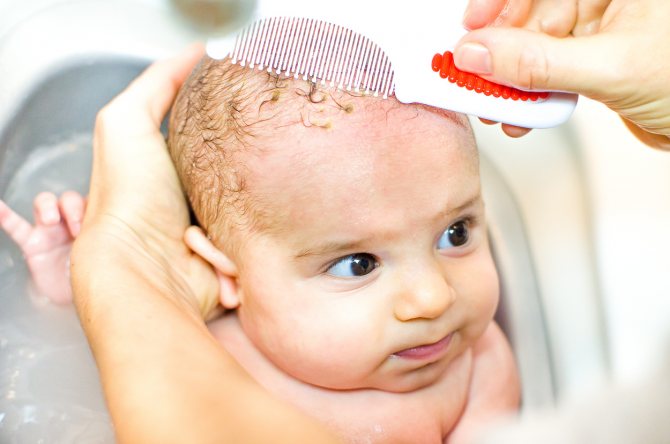
Baby being combed
Treatment methods
If the baby does not show any signs of rickets, in addition to a receding hairline, and the child is active, eats well and sleeps peacefully, then do not worry. In newborns, wiping hair on the back of the head is a common occurrence. No treatment is required in this situation. The hair will grow back. To prevent it, it is recommended to turn the baby from one side to the other, and when he grows a little, it is permissible to place a cushion under his head. To treat rickets, vitamin complexes, vitamin D, frequent walks in sunny weather, massage sessions, and physiotherapy are prescribed.
It is necessary to closely monitor the baby’s behavior and promptly treat diseases. A strong immune system will prevent serious pathologies. If concomitant symptoms are detected, it is necessary to undergo diagnostics and identify pathological processes at an early stage. A healthy child means happy parents.
How to shave correctly
To shave a newborn's hair, you need to prepare all the tools in advance. It is better to carry out the procedure while swimming. You will need:
- razor;
- baby shampoo;
- toys.
It is worth rescheduling shaving to another day if the baby is in a bad mood. Parents must be sure that the procedure will not harm him. How to shave a baby's head, step-by-step algorithm:
- Draw a bath of water for the baby.
- They give him time to calm down and get carried away with toys.
- Use dry scissors to cut long strands, if any.
- Lather your hair with baby shampoo.
- The hair is removed from the head with a razor.
Be sure to follow some tips during the process:
- Shaving begins from the bottom at the back; if the baby starts to act up, the shaved area will not be visible.
- Use only baby shampoos to avoid drying out the scalp.
- There is no need to shave your baby if not all of his milk crusts have fallen off - you can damage the skin.
- Select razors with a soft roller so as not to scratch the baby’s head.
- The razor blades are directed against the growth of the rods.
- The procedure is stopped if the child is frightened and very capricious.
- If you have a hair clipper, it is better to use it on the smallest attachment.
Dr. Komarovsky advises shaving a one-year-old child once to ensure even growth of all the rods. However, he urges not to get carried away with the procedure. This will not make your hair thicker or thicker. The color and structure of the hairline are inherited; it is impossible to influence it by external factors.
Important! Dry indoor air damages the hair structure.
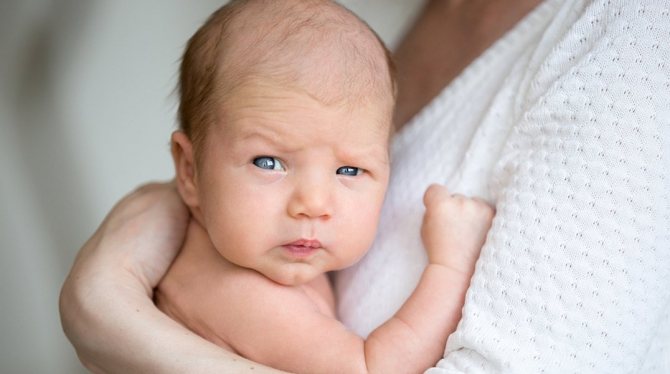
Baby in mother's arms
If your child has poor hair growth
How hair grows on newborns' heads
If your child has bad hair, your pediatrician will tell you what to do. The reasons may be different:
- heredity;
- some congenital diseases;
- hormonal disorders;
- poor nutrition.
The rate of hair growth can change with age. Therefore, a baby who looks completely bald may well become the owner of a beautiful and voluminous hairstyle in a few years. Parents should, first of all, think not about hair growth, but about how to provide the child with good nutrition and a sufficient amount of physical activity, then the hair will look good.
Hair care
A baby's hair is thin and fragile and requires proper care. It's okay if they fall out. Only by the age of 5 years does permanent hair form. Required care:
- Shampoos and other hair washing products are chosen with a neutral acidic environment. It is forbidden to use adult shampoos and soaps - they have a negative effect on the skin, dry it out, and some hairs may fall out.
- Try to wash the baby's head with plain water as often as possible. Shampoos are allowed to be used no more than once a week.
- It is allowed to use herbal decoctions for rinsing. They heal the scalp and add shine, especially to blond hair. A preliminary test is made to determine if there is an allergy to the plant.
- Wet hair is carefully blotted with a towel after bathing.
- Comb your head after it is completely dry so as not to damage the hair shafts.
- Bathing is carried out 1-1.5 hours before bedtime, so that the hair has time to dry completely.
- Use special baby combs with soft teeth so as not to scratch the baby. After each brushing, wash them with soap and water.
- It is forbidden to use hair dryers for drying - they seriously damage the hair shaft and skin. Baby hairs dry quickly and there is no need to use them.
- If your baby's hair is tangled into a knot, it needs to be carefully trimmed with scissors.
- You need to shave no more than once every 3 months.
Every parent wants their child to have beautiful and strong hair, especially mothers of girls. Don't worry if your baby was born bald or with thin hair. By 2-3 months they will completely change to new ones. By the age of 5, permanent hair will have formed.
How to care for baby's hair?
- The baby should wash his hair with shampoo (with a neutral pH), and not with soap that has an alkaline pH, and no more than once a week, since even the most gentle shampoos, if used frequently, can cause the protective film to be washed away from the scalp, which will lead to drying out the skin.
- Hair must be rinsed thoroughly so that no shampoo or soap remains on it. If your baby has long hair, you can use special baby rinses. For rinsing, you can also use decoctions of various herbs (chamomile, sage, calendula - anti-inflammatory, string - anti-allergic, nettle - to strengthen hair roots). These decoctions can be used without special indications, but with some caution: some herbs can cause allergies in a child.
- Both the baby’s skin and hair should not be wiped, but blotted with a soft towel or diaper. Vigorous scrubbing can damage your baby's hair and delicate skin.
- Comb thick and long hair when it is almost dry. To do this, use special combs, preferably made from natural materials (wood, bone). Natural materials of combs have an antistatic effect, irritate the skin less, and hair splits less.
There is an opinion that at the age of 1 year the baby should be shaved bald. Is this really true? - No! It has been proven that shaving a baby's head bald does not have any effect on the quality of growth and quantity of hair. But it can damage a child’s skin. If a child has thin and brittle hair, it needs to be cut regularly (every 1-2 months) or trimmed by 0.5 cm. If the condition of the child’s hair is normal, then cutting it in the first year does not make sense. Hair cutting really becomes necessary if the hair is so thick that it forms bangs that obscure the eyes.
